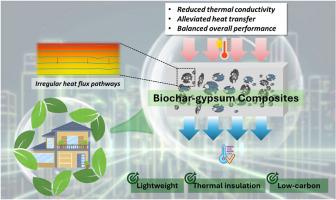Enhanced thermal insulation of biochar-gypsum composites
IF 10.8
1区 工程技术
Q1 CONSTRUCTION & BUILDING TECHNOLOGY
引用次数: 0
Abstract
Low-carbon and energy-efficient construction materials are crucial in mitigating the environmental impact of the construction industry while enhancing energy efficiency within buildings. Here, we developed sustainable, lightweight biochar-gypsum composites with enhanced thermal insulation properties for building applications. Biochar, a wood waste-derived carbon-negative material in this study, was integrated into gypsum plaster at various dosages to assess its impact on thermal insulation and mechanical performance. The results demonstrated that biochar addition significantly reduced thermal conductivity, with a maximum reduction of 65% (from 0.77 to 0.27 W/(m·K)) at 60 wt% biochar with pores as thermal barriers. Simulation results revealed that irregular heat flux pathways could alleviate heat transfer by delaying temperature equilibration across the biochar-gypsum composites. However, a high biochar content reduced mechanical properties, with compressive strength decreasing from 22.3 MPa (0 wt%) to 1.7 MPa (60 wt%). Moderate biochar addition (20 wt%) balanced the overall performance, reducing thermal conductivity by 40% while maintaining a compressive strength of 4.7 MPa. These findings highlight biochar-gypsum composites as eco-friendly construction materials that can enhance energy efficiency and foster waste valorisation in sustainable construction.


增强生物炭-石膏复合材料的隔热性能
低碳和节能的建筑材料对于减轻建筑业对环境的影响,同时提高建筑物内的能源效率至关重要。在这里,我们开发了可持续的轻质生物炭-石膏复合材料,具有增强的建筑隔热性能。生物炭是一种木材废料衍生的负碳材料,在本研究中,生物炭以不同的剂量掺入石膏中,以评估其对隔热和机械性能的影响。结果表明,添加生物炭显著降低了热导率,当生物炭重量为60%时,孔隙作为热障,热导率最大降低65%(从0.77 W/(m·K)降至0.27 W/(m·K))。模拟结果表明,不规则的热流通量路径可以通过延迟生物炭-石膏复合材料的温度平衡来减轻传热。然而,高生物炭含量降低了机械性能,抗压强度从22.3 MPa (0 wt%)下降到1.7 MPa (60 wt%)。适度添加生物炭(20% wt%)平衡了整体性能,降低了40%的导热系数,同时保持了4.7 MPa的抗压强度。这些发现强调了生物炭-石膏复合材料作为环保建筑材料,可以在可持续建筑中提高能源效率并促进废物增值。
本文章由计算机程序翻译,如有差异,请以英文原文为准。
求助全文
约1分钟内获得全文
求助全文
来源期刊

Cement & concrete composites
工程技术-材料科学:复合
CiteScore
18.70
自引率
11.40%
发文量
459
审稿时长
65 days
期刊介绍:
Cement & concrete composites focuses on advancements in cement-concrete composite technology and the production, use, and performance of cement-based construction materials. It covers a wide range of materials, including fiber-reinforced composites, polymer composites, ferrocement, and those incorporating special aggregates or waste materials. Major themes include microstructure, material properties, testing, durability, mechanics, modeling, design, fabrication, and practical applications. The journal welcomes papers on structural behavior, field studies, repair and maintenance, serviceability, and sustainability. It aims to enhance understanding, provide a platform for unconventional materials, promote low-cost energy-saving materials, and bridge the gap between materials science, engineering, and construction. Special issues on emerging topics are also published to encourage collaboration between materials scientists, engineers, designers, and fabricators.
 求助内容:
求助内容: 应助结果提醒方式:
应助结果提醒方式:


